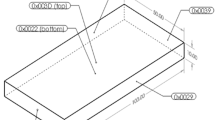Abstract
Nowadays, companies are developing more and more collaborative projects, and hence the need to exchange data with many partners, contractors, subcontractors, suppliers, and customers. So, to establish successful collaborations, they must ensure the relevance, coherence, and especially the security of exchanged data. But the Computer-Aided Design (CAD) systems still have gaps that need to be corrected in order to improve the productivity of the design process: they offer few solutions to maintain data consistency within the digital model. Adding to that poor management of changes, the user has to manage the consequences of each change manually. This research explores the role of mates’ assembly, as defined in CAD systems, as a key to maintaining the links between parts in the assembly. In this work, we propose the CAD Assembly Management Model that is based on reference elements, in order to maintain mates between CAD entities when a part is modified by a partner and then reinserted into the assembly CAD, and then propagate changes.
Access this chapter
Tax calculation will be finalised at checkout
Purchases are for personal use only
Similar content being viewed by others
References
Choi G, Mun D, Han S (2002) Exchange of CAD part models based on the macro-parametric approach. Int J CAD/CAM l2(1):13–21
Demoly F, Toussaint L, Eynard B, Kiritsis D, Gomes S (2011) Geometric skeleton computation enabling concurrent product engineering and assembly sequence planning. Comput Aided Des 43(12):1654–1673
Eger T, Eckert C, Clarkson PJ (2007) Engineering change analysis during ongoing product development. In: International conference on engineering design, Iced’07 28–31 August 2007, Cité des sciences et de l’Industrie, Paris, France
Fouda P, Danloy J, L’Eglise T, De Lit P, Rekiek B, Delchambre A (2001) A heuristic to generate a precedence graph between components for a product family. In: International symposium on assembly and task planning (ISATP2001), 29 May
Hwang J, Duhwan M, Soonhung H (2009) Representation and propagation of engineering change information in collaborative product development using a neutral reference model. Concurr Eng (SAGE Journals)
ISO 10303-11 (1994) Industrial automation systems and integration—product data representation and exchange—Part 11: Description methods: the EXPRESS language reference manual, Geneva, Switzerland. International Organization for standardization (ISO)
ISO 10303-42 (2003) Industrial automation systems and integration—product data representation and exchange— art 42: Integrated generic resource: geometric and topological representation, Geneva, Switzerland. International Organization for Standardization (ISO)
Leilei Y, Dunbing T, Yuyun K, Sheng L (2014) Topology face–based change propagation analysis in aircraft assembly tooling design. Proc Inst Mech Eng Part B: J Eng Manuf (SAGE Journals)
Li GD, Zhou LS, An LL, Ji JF, Tan CB, Wang ZG (2010) A system for supporting rapid assembly modeling of mechanical products via components with typical assembly features. Int J Adv Manuf Technol 46:785–800
Louhichi B, Rivest L (2012) Management of associations within digital mock-ups for improved collaboration, PLM12: product lifecycle management: towards knowledge-rich enterprises. In: The IFIP WG5.1 9th international conference on product lifecycle management, 9th–11th July, École de Technologie Supérieure, Montreal, Canada. ISBN: 978-2-921145-82-4
Louhichi B, Rivest L (2014) Maintaining consistency between CAD elements in collaborative design using association management and propagation. Comput Ind 65:124–135
Mascle C, Jabbour T, Maranzana R (1997) Assembly features for mechanical product data. In: Proceedings of the IEEE international symposium on assembly and task planning (ISATP’97)—towards flexible and agile assembly and manufacturing, 7–9 August
Mun D, Han S, Kim J, Oh Y (2003) A set of standard modeling commands for the history-based parametric approach. Comput Aided Des 35(13):1171–1179
Reddi K, Young M (2009) A framework for managing engineering change propagation. Int J Innovation Learn 6(5)
Author information
Authors and Affiliations
Corresponding author
Editor information
Editors and Affiliations
Rights and permissions
Copyright information
© 2018 Springer International Publishing AG
About this paper
Cite this paper
Eltaief, A., Louhichi, B., Remy, S., Eynard, B. (2018). A CAD Assembly Management Model: Mates Reconciliation and Change Propagation. In: Haddar, M., Chaari, F., Benamara, A., Chouchane, M., Karra, C., Aifaoui, N. (eds) Design and Modeling of Mechanical Systems—III. CMSM 2017. Lecture Notes in Mechanical Engineering. Springer, Cham. https://doi.org/10.1007/978-3-319-66697-6_45
Download citation
DOI: https://doi.org/10.1007/978-3-319-66697-6_45
Published:
Publisher Name: Springer, Cham
Print ISBN: 978-3-319-66696-9
Online ISBN: 978-3-319-66697-6
eBook Packages: EngineeringEngineering (R0)




